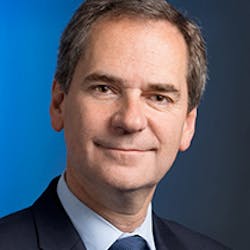Keynote Discussion: A conversation with Andy Mattes, CEO, Coherent

Laser Focus World Editor in Chief John Lewis had a lively conversation with the CEO of Coherent, Andy Mattes, a native German who had taken over the leadership of Coherent from John Ambroseo in April 2020. That was in the middle of the first COVID-19 wave; accordingly, Lewis’ first question addressed that challenge. Mattes said he created a steering committee with weekly meetings to review employee safety, manufacturing readiness, supply chain, customer reactions, and service—“the whole gamut.” The revenue numbers went down between April and June 2020, but have recovered strongly ever since. “In some cases, we're actually above pre-COVID levels,” Mattes said (see figure).
The actual challenge was an immediate change toward a virtual company. While this transition had to be executed immediately, Mattes found great benefits in the outcome of virtualization. Inside the company, communication became much more democratic, as more people spoke up more freely. This is a benefit that Mattes wants to retain, “because more bright minds speaking up will lead to better solutions.” For conversing with customers, it became much easier to involve more experts: “You have a more diverse group of people on both sides, which means you get more done in a single call.”
On the economic side, customers were holding back orders when COVID began. The company had to balance this with their own inventories accordingly, and then came a rebound effect when people started refilling inventories. While Mattes sees Coherent back to normal now, some customers are even beginning to order more in advance, especially in the microelectronics and semiconductors space. An early communication with all suppliers turned out to be a crucial success factor for Coherent within the COVID crisis.
Asked for new and exciting trends, Mattes is thrilled by OLEDs: He sees them as a solution for almost all mobile devices. In five or seven years, he expects micro-LEDs to advance, to the point where laser technology would not only be used for annealing the backplane, but also for the laser-induced forward transfer of the micro-LEDs onto the final substrate. When micromachining advances to support 5G roll out, he sees ultrafast lasers on the forefront.
Beyond such electronics advances, he expects substantial progress in the medical field (namely flow cytometry), but also in the defense and aerospace sectors. A major revenue driver will be the transition to electric vehicles, where lasers are critical for the manufacturing of battery cells.
Such a diversification in products and markets will certainly provide resiliency against market fluctuations. On the other hand, this resiliency requires a very specific organization that is adapted to the needs of the various clients. To create many different and targeted organizational structures, Coherent has established a customer-centric sales organization on the front end and a technology-centric organization on the back end.
When all is said and done, Mattes is very optimistic about the future of Coherent, but will he find the necessary talent for such an ever-growing high-tech company? While Coherent puts a lot of effort in finding and retaining talent straight out of universities, Mattes was surprised when he learned about the loyalty within the Coherent workforce: “the average employee of our company has more than 10 years of service—and this is basically unheard of in the [Silicon] Valley.” The unsolved challenge he sees is the gender balance in the photonics field: “That is something that we as an industry, together with all the universities around the world, have to work on.”
CONTINUE READING >>>

Andreas Thoss | Contributing Editor, Germany
Andreas Thoss is the Managing Director of THOSS Media (Berlin) and has many years of experience in photonics-related research, publishing, marketing, and public relations. He worked with John Wiley & Sons until 2010, when he founded THOSS Media. In 2012, he founded the scientific journal Advanced Optical Technologies. His university research focused on ultrashort and ultra-intense laser pulses, and he holds several patents.